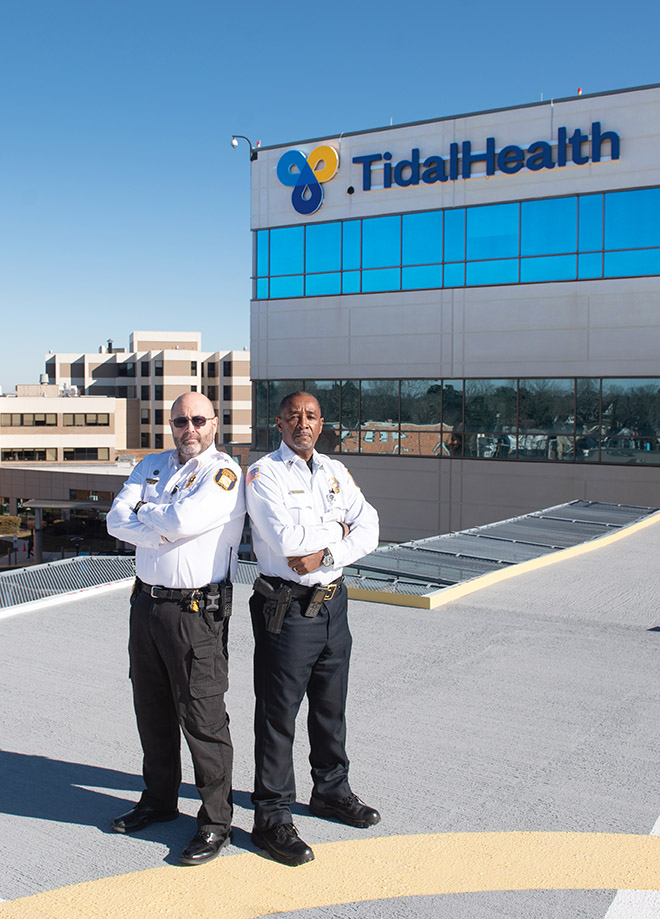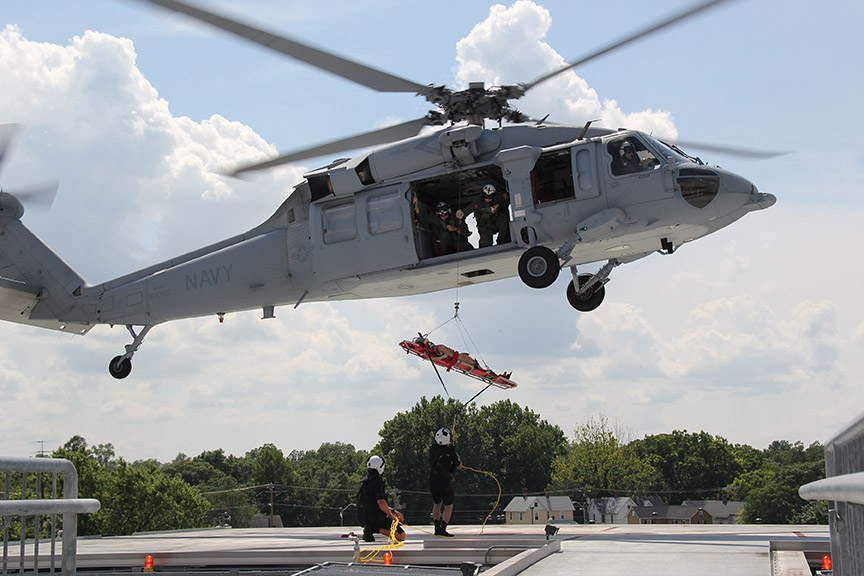TidalHealth helipads save lives when tragedy strikes
A voice comes across the radio and it’s showtime.
SYSCOMM: Trooper 4 inbound, ETA 10 minutes.
Anthony Tull, Captain of TidalHealth’s Special Police, weaves through the hallways making his way to the Layfield Tower helipad. He secures an elevator and instructs the switchboard to page the trauma team.
Throughout his 33-year career, he’s been summoned to thousands of chopper landings, and one thing remains constant: the adrenaline rush that courses through his body when the call comes in.
“You just never know what you’re going to get,” he said. “You have this feeling of concern and compassion, and you do whatever you can to help save a life.”
Designated a Level III Trauma Center by the American College of Surgeons — meaning it can provide emergency services including resuscitation, surgery, intensive care and stabilization — TidalHealth Peninsula Regional sees hundreds of patients transported by air each year.
Given the vast geographic area that TidalHealth serves, medical air transportation is invaluable; more than 500,000 people live in the health system’s seven-county service area, and another 8 million people vacation at the Shore annually.
“Air transportation is crucial for critical patients to reach a specialized staff that’s prepared to care for their trauma and medical needs,” said Angie Brittingham, Director of Emergency and Trauma Services for TidalHealth Peninsula Regional. “It cuts travel times from hours to minutes for our area.”
In 2019, the helipads at TidalHealth Peninsula Regional made it possible for more than 250 critically ill patients to get the rapid care they needed.
“Time is always of the essence for these patients,” said Sarah Arnett, Chief Nursing Officer at TidalHealth Peninsula Regional. “The ability to continue life-saving medications, coupled with an expedient mode of transportation and highly skilled transport teams, ensures us that we have provided every opportunity for our patients to achieve a positive outcome.”

When a patient is transported to TidalHealth Peninsula Regional via helicopter, the trauma team and a member of the Special Police are called to the helipad to escort the patient to the Emergency Department.
Lifting up our community
At TidalHealth Peninsula Regional, the first helipad was constructed in 1977 on the roof of the East Tower. In 1990, as helicopters were becoming larger and heavier, a new helipad was constructed to accommodate the additional weight that the rooftop pad could no longer support.
This new helipad, located on Vine Street across from the former Emergency Department, was built on columns about 20 feet off the ground. In 2004, as the hospital made plans to construct the Layfield Tower and relocate the Emergency Department, that helipad was deconstructed and a new helipad was built on top of the East Tower.
In 2008, the newest helipad was constructed on the third floor of the Layfield Tower thanks to a generous donation from Ocean City business owner and philanthropist Leighton Moore. The goal was to get incoming patients closer to the Emergency Department and critical care areas upon arrival.
Moore, former Chairman of the TidalHealth Foundation Board and a longtime donor to TidalHealth Peninsula Regional, said he was happy to help.
“As a tertiary hospital — the one this area depends on most — we need more than one helipad,” he said. “You give what is needed for the benefit of the community, and medical care is definitely something the community needs the most.”
Today, both the East Tower and Layfield Tower helipads are operational, and both are used to expedite care.
Each year, patients are transported by Maryland State Police, Delaware State Police, LifeNet, Johns Hopkins, University of Maryland and Children’s National Medical Center, to name a few.
When a call comes in, the trauma team — escorted by a special police officer — reports to the helipad and works with the responding agency to safely transport that patient inside, where the appropriate care can be delivered.

Chief Bo Kennedy and Captain Anthony Tull of TidalHealth Special Police often accompany the trauma team to the helipad when critically ill patients arrive for care.
More than patient transport
In addition to patient transport, the helipads serve another purpose in our community: vital training for first responders.
Several times a year, teams from the U.S. Coast Guard, the U.S. Navy and the Maryland State Police travel by air to TidalHealth Peninsula Regional to complete emergency preparedness drills.
“This is how they train new pilots,” said Bo Kennedy, Chief of TidalHealth’s Special Police. “They practice touch-and-go landings and basket drops, which are executed when their helicopters are too big to land on our pad and they have to drop a patient down to our care team by basket.”
Rooftop landings are a thing of the past as new structures have been built that can withstand more weight. At TidalHealth Peninsula Regional, the helipads can sustain 15,000 pounds and accommodate choppers with a rotor length of 45 feet.
Kennedy has seen his fair share of emergencies, and is comforted to know that medical air travel is available to those who need it.
“It’s the absolute quickest way to get the care you need,” he said. “You can go from here to Baltimore in less than 30 minutes when it might take an ambulance three hours or more. It speeds up the care and ultimately saves lives.”

Teams from the U.S. Navy frequently use the helipads at TidalHealth Peninsula Regional for life-saving drills and exercises in emergency preparedness.
